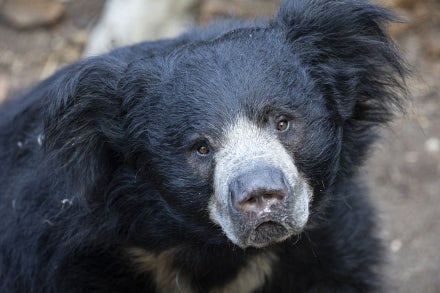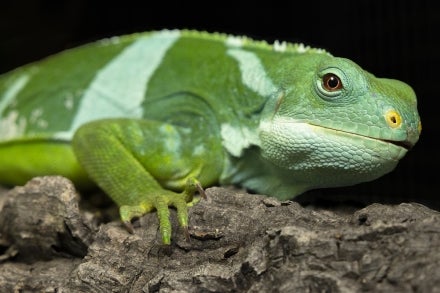
Complexity Is Key
Figuring out a puzzle to unlock a treasure of raisins. Climbing up swinging branches to a cozy hammock made of woven firehose. Head butting a big pile of dirt until it’s been vanquished. Discovering that there’s one rock that stays nice and toasty for lounging, even on a chilly day. Just what are these animals up to? They’re taking full advantage of enrichment. [youtube video=ttps://youtu.be/AsFILR6_GyQ]Puzzling It Out
One category of enrichment is to provide animals with cognitive challenges: things to get them thinking. This might be learning how to use a puzzle to get a food treat, or figuring out how to negotiate a new arrangement of branches and platforms to reach a favorite sleeping spot. It might also be assessing a new item in the habitat, determining if it’s a threat or not, or how it might be used. Cognitive enrichment also includes positive reinforcement husbandry training: learning to follow the cues given by a keeper or trainer to present a desired behavior, then receive positive reinforcement, like a food treat or verbal praise, in return.Food for Thought
Ways of finding, obtaining, processing, and eating food are one type of enrichment. In the wild, animals spend a large portion of their time on food, so it makes sense to provide similar opportunities for zoo animals. Whether an animal digs for its food, reaches up high to browse, forages for fruit or insects, or sniffs out a meal gives keepers ideas for different ways to present an animal with its meals. Animals will even leave the easy pickings and spend time working to obtain the harder-to-get food, apparently just because it’s more of a challenge!
Both Useful and Fun
There are a wide variety of objects and items that can be offered to animals for them to use and interact with as they see fit. They may use items as something new or interesting to explore, as a toy to play with, as something to make themselves comfortable, or in some other way—the important thing is, they get to decide.
Time to Explore
The features and structure of an exhibit habitat are a big part of enrichment. Finding new logs to scratch or rip apart, rocks to climb, or plants to chew are exciting discoveries. A sand, dirt, or mud pit to roll in, a pool to cool off and lounge in, branches that move and sway, and structures to climb provide varied activities, exercise, and ways to self maintain.
Senses and Sensibility
Scents and sensations are certainly enrichment. Animals are highly attuned to their senses of hearing, sight, smell, taste, and touch, and making use of them broadens their experiences. This is especially important for young animals, as they grow and learn. Unexpected sensational surprises, like snow or ice, can elicit quite a bit of excitement. Smelling the scent of another animal in used straw will spark interest—as will the scent of prey in the air as a carnivorous lizard tongue-flicks its way to the prize. Even sensations like temperature play a role—choosing to move into the shade where it's cooler, or dozing in the sun to soak up the heat.
Social Life
Appropriate social groups are important in enrichment. For social species, they need to be part of a group; but others need their solitary time. Then there are also the interesting and varied experiences of living in mixed-species groups and encountering other types of animals. Who has what territory? What behavior is required in certain situations? Do we need to be on guard?
 GROUP ACTIVITY
GROUP ACTIVITYGiving the animals opportunities to make their own choices and control their environment is an important aspect of enrichment. Hang together with the herd? Browse on your own for a while? Lounge in the shade, or go for a gallop to the next grassy hillside? As much as possible, it should be their decision.[/caption]




